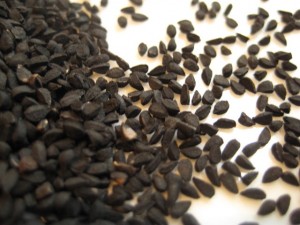Nigella
Scroll down for resources and a recipe.
The Basics
Nigella is a small, pitch black seed with a pronounced edge. It’s not a common spice shelf staple in the U.S. but is quite popular with other ethnic cuisines. Chances are you’ve run across this spice before when it was incognito. Meaning, there seems to be a trend to refer to this seed spice by calling it the black version of other seed spices. Black cumin, black caraway, black sesame seeds, or black onion seeds. This is too bad because nigella has a distinct flavor and merits recognition based on its own contribution to flavor. It’s also called charnushka as a spice that tops an Eastern European rye bread.
Nigella is popular in curries, meat dishes, chutneys, vegetables, naan bread and pastries. It’s popular in breads as a partner with caraway seeds.
The Form
Some of the name confusion comes because nigella isn’t well-known but its shape resembles that of other more popular spices. Nigella is about the size of a sesame seed but it’s midnight black. Unlike a soft sesame seed nigella is nearly rock hard, more like a pepper corn than must be ground with a mortar and pestle or another type of spice grinder.
The Flavor
Nigella seeds, in their whole form, have very little detectable fragrance. Crack them open, even slightly, and you get the impression that clouds of aroma have been brewing inside the seed just waiting for the opportunity to be released. The scent and flavor have a distinct peppery punch overlaid with the sharp lines of cumin. It’s popular with Middle Eastern and Indian dishes. The flavor is intensified and like many spices benefits from being lightly toasted in a hot dry cast iron skillet for a few moments.
Try it with tomatoes, squash, potatoes, or bitter greens. Sprinkle a bit of the roasted seeds on flat breads like naan or cook it into other breads. It’s good with meats. I prefer it with red meats or white meats with a richer vegetable-based sauce.
The Story
There are claims that there are references to a plant in the bible that is nigella which would make this spice more than a couple of millenia old. Personally, I always find something intriguing and historically romantic about flavoring my food with the same spices used by the Ancients.
For the etymology geeks(like me): the color of nigella is synonymous with black. The name for nigella across nearly every culture and language is a derivative of that language’s name for black. For example, the Latin name is nigella and in Latin the word for black is niger. The Finnish call nigella mustakumina and the Finnish word for black is musta. Here’s a chart listing nigella in over 20 languages along with each language’s respective word for black. It’s very interesting and kudos to author Gernot Katzer for taking the time to put it together.
Resources:
Dean & Deluca’s nigella comes in an attractive tin for $4.50
Try it!
Here’s a yummy turkey burger recipe from a Washington Post article on nigella. It’s adapted from The Farmer’s Market Cookbook
by Chef Richard Ruben.
2 tablespoons olive oil
1 medium onion, cut into small dice (1 cup)
2 medium cloves garlic, crushed to a paste with a little kosher salt
2 teaspoons zaatar (a Middle Eastern spice blend often composed of ground sesame seeds, dried thyme, dried marjoram and sumac)
1 tablespoon nigella seeds (see headnote)
1 pound (uncooked) ground turkey
1/4 pound feta cheese, crumbled (about 1 cup)
Leaves from 2 or 3 sprigs thyme, chopped (2 teaspoons)
Freshly ground black pepper
Heat 1 tablespoon of the oil in a medium nonstick or cast-iron skillet over medium heat. Add the onion and cook slowly over a medium low heat, stirring occasionally, until browned at the edges. Transfer to a medium bowl and add the garlic, zaatar and nigella seeds, stirring to incorporate. Let cool completely.
Meanwhile, add the ground turkey, feta, thyme and pepper to taste to the cooled onion mixture. Use your clean hands to form the mixture into 6 patties. Working in batches, add 3 or 4 of the patties to the skillet, being careful not to overcrowd. Cook for about 6 minutes until browned on the bottom, then turn them over and cook for 4 to 6 minutes, until fully cooked (but not dry). As the turkey burgers are done, transfer to a plate and cover loosely with aluminum foil to keep warm. Add the remaining patties to the skillet (no more oil will be needed) and repeat the cooking process.




3 Pingbacks